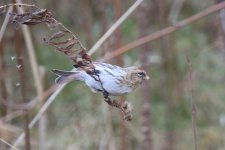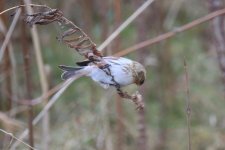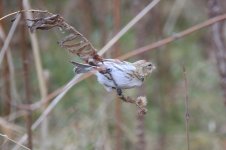Interesting individual imo. A female/1w? At this time of year, as a precautionary tale, all Redpolls can generally look quite whitish in relatively fresh plumage but a Hoary doesn’t to have clean white flanks or immaculate white undertail coverts (utcs) so the following comes with that big proviso but thinking out loud ....
- Firstly, Greater’, Common Redpoll, (A.f.rostrata) is darker on the face and upperparts with much heavier streaking and bulkier than the OP, so can probably be straight away ruled out. It is also less common on range perhaps than ‘Southern’ Common Redpoll,( A.f.flammea).
- There are two subsp of Hoary, ‘Southern’ A.h.exilipes (which overlaps in range with flammea) and ‘Hornemann’s’, Hoary, which is larger than the latter and the palest of all. Hornemann’s can be ruled out straight away on account of the undertail coverts which are immaculately white in Hornemanns.
Which leaves
flammea (Southern Common) or
exilipes (Southern Hoary).
- Female Hoary exilipes can show some limited streaking on the undertail coverts and a central dark line on the utcs as the OP shows. I have seen a few Arctics with at least a few fine streaks on the utcs and certainly with a dark streak on the central utc.
- The red patch may be placed a little far back for exilipes but this might just indicate female (which have smaller red patches in either ssp. )
- The bill looks borderline to me and there is occasional overlap in bill sizes (I think?) it’s a shame it’s out of focus/and has a feather in it! (no offense) but it’s hard to judge, although to me it looks as if it could fit at the higher end of the scale for exilipes and the lower end for flammea. Structurally, the bill does looks more conical in shape than the stubbier shape of Hoary. However, shadow and varying amounts of black feathering surrounding the bill base/nostrils can change impression of how ‘pushed in’ a bill can look on flammea and how long it looks too.
- The streaks on the flanks are quite light and look pale greyish brown rather than warm cinnamon brown which favor exilipes imo.
- However, it’s the general overall paleness of this bird that strikes me more than anything (not just the flanks and belly either) although the contrast of the warm ear coverts with the much paler head is quite pronounced (more than I would expect to see on exilipes ). The flank streaking looks very fine and light and the head also looks quite frosty, which would support Hoary. The buff on the upper chest is quite limited as is the streaking around the shoulders and breast sides. Even as an early winter bird, it is pale enough for a exilipes imo with the proviso that is is still in quite fresh plumage and we have no view of the mantle, scapulars or rump.
The OP seems to be one of those intermediate individuals imo, very pale and within range for Arctic, showing light greyish brown flank streaks, fine utc streaking with a central dark streak which is acceptable in adult female Hoaries (although to what extent?) However, aging and sexing anything other than adult males is very difficult. The bill is hard to properly determine, although looking better for Common. I would personally be cautious in assigning it to Common although, if I had to make a decision in that direction I would. However, I would feel happier to do so, if I could see a sharper image of the bill shape and best of all a clear view of the rump (which I suspect would be quite pale if not white) and therefore comfortably rule out Hoary. I would be even happier to look at the same bird in 2 or 3 months time!
Some references here
and of course Sibley’s which I haven’t had time to read but I am sure will provide some good identification criteria for you

www.sibleyguides.com
Sorry, that’s probably not much help, given the hesitant answer!








